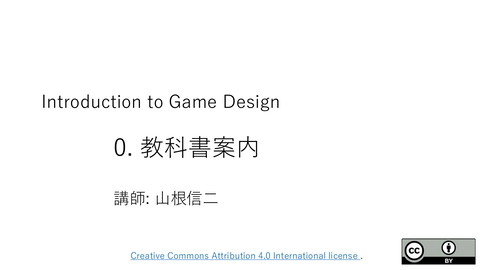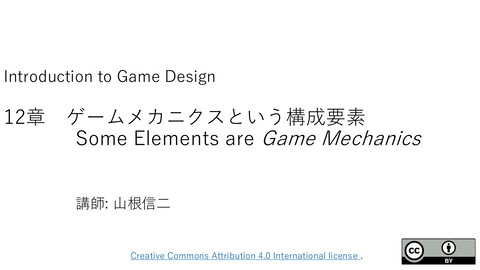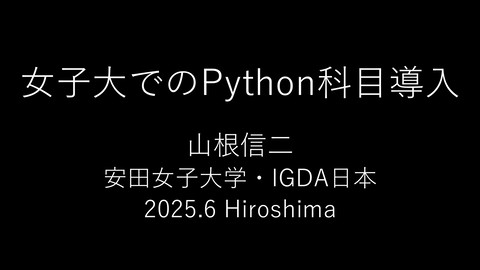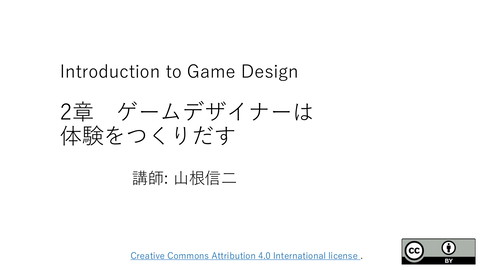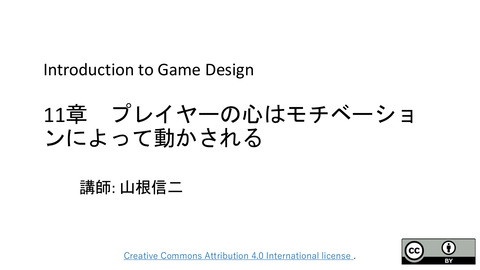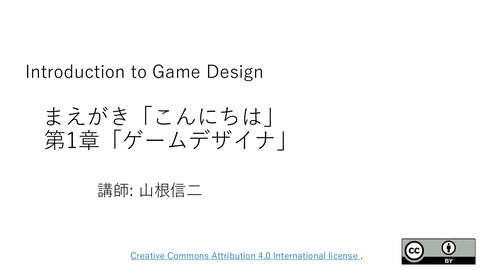Archival Perspective on the Social History of Computing (2005)
>100 Views
June 10, 05
スライド概要
Presented at IEEE ISTAS2005, 10 June 2005.
Game Jammer working at Yasuda Women's University since April 2025. IGDA Japan board member, HEVGA individual member. 2025年より安田女子大学に移りました.
関連スライド
各ページのテキスト
Introduction Related Study Rise of new groups of computer experts Conclusion Archival Perspective on the Social History of Computing Shinji R. Yamane 1 Akira Baba 2 1 Graduate School of Interdisciplinary Information Studies, University of Tokyo 2 Interfaculty Initiative in Information Studies, University of Tokyo ISTAS2005 Friday 10 June, 10:15–11:45, Room 1218. S. Yamane ISTAS2005 TS–III–A–2
Introduction Related Study Rise of new groups of computer experts Conclusion Contents I Related Study: New direction of the history of computing I Computer experts’ grass-roots community I Problem on archiving I Case study: CPSR archive Background Archiving Strategy I Problems appeared in the pilot project I What to Save, How to Save, How to Use I I I Consideration and Future Work S. Yamane ISTAS2005 TS–III–A–2
Introduction Related Study Rise of new groups of computer experts Conclusion Related Study (1/3) Related Study (2/3) Related Study (3/3) Archival Perspective Related Study (1/3) Kevin W. Bowyer. “Star Wars” revisited: A continuing case study in ethics and safety-critical software. ISTAS’01. I Editor of Ethics and Computing: Living Responsibly in a Computerized World (IEEE Press, 1996, 2000) I Teaching ethics and computing using Case Study I Reprinted in IEEE Technology and Society Magazine 20(1), 2002. S. Yamane ISTAS2005 TS–III–A–2
Introduction Related Study Rise of new groups of computer experts Conclusion Related Study (1/3) Related Study (2/3) Related Study (3/3) Archival Perspective Related Study (2/3) Nathan L. Ensmenger. Power to the People: Toward a Social History of Computing. IEEE Annals of the History of Computing 26(1), 2004. “We know something about a few of the more famous inventors, entrepreneurs, and computer scientists, but we need to understand more about the many thousands of largely anonymous individuals who contributed to the development of this new social and technological environment.” S. Yamane ISTAS2005 TS–III–A–2
Introduction Related Study Rise of new groups of computer experts Conclusion Related Study (1/3) Related Study (2/3) Related Study (3/3) Archival Perspective Social construction of the Personal Computer User cited from Bardini and Horvath (1995) S. Yamane ISTAS2005 TS–III–A–2
Introduction Related Study Rise of new groups of computer experts Conclusion Related Study (1/3) Related Study (2/3) Related Study (3/3) Archival Perspective Related Study (3/3) Rebecca Slayton. Technical authority in the media: Public debate on the Strategic Defense Initiative. ISTAS’01. I Mass media analysis: Social construction of technical authority I Rebecca Slayton. Speaking as scientists: Computer professionals in the Star Wars debate. History and Technology. 19(4), 2003. −→ turned to cover not only mass media, but also CPSR members’ newsletters, email lists, personal communications, etc. S. Yamane ISTAS2005 TS–III–A–2
Introduction Related Study Rise of new groups of computer experts Conclusion Related Study (1/3) Related Study (2/3) Related Study (3/3) Archival Perspective Archival Perspective Past studies used grass-roots community resources for: I teaching computer ethics, I audio / visual records for informal discussion, I analysis on the particular group of computer users who invent and reinvent the computers What kind of archive do we need for further studies? Archival strategy is required to decide: 1. What to save (What to digitize), 2. How to save it, and 3. How to provide access to it. S. Yamane ISTAS2005 TS–III–A–2
Introduction Related Study Rise of new groups of computer experts Conclusion Case Study: CPSR archive CPSR activities: Characteristics Pilot project Case Study: Archiving CPSR institutional memory I How can we see the record of grass-roots community? I What’s the difference with others, i.e., the university archive or corporation archive? S. Yamane ISTAS2005 TS–III–A–2
Introduction Related Study Rise of new groups of computer experts Conclusion Case Study: CPSR archive CPSR activities: Characteristics Pilot project Social construction of the Personal Computer User How about the professional communities? S. Yamane ISTAS2005 TS–III–A–2
Introduction Related Study Rise of new groups of computer experts Conclusion Case Study: CPSR archive CPSR activities: Characteristics Pilot project Representations of the Computer Professional Groups Example: the member list of Aspen Institute summit on computing research policy (1992): I AAAI (American Association for Artificial Intelligence) I ACM I CPSR I CRA (Computing Research Association) I CSPP (Computer Systems Policy Project) I CSTB (Computer Science and Telecommunications Board) I IEEE Computer Society I SIAM (Society for Industrial and Applied Mathematics) S. Yamane ISTAS2005 TS–III–A–2
Introduction Related Study Rise of new groups of computer experts Conclusion Case Study: CPSR archive CPSR activities: Characteristics Pilot project Wide range of CPSR activities and records I CPSR had been originally conceived as a group concerned about the arms race and nuclear war, however, its activities are not limited to military application of computing. I Subsequently, CPSR expanded its educational and scientific activities from its early years. Directions and Implications of Advanced Computing (DIAC) Participatory Design Conference (PDC) I Conference on Computers, Freedom, and Privacy (CFP) (since 1991) I I I Getting Special Consultative Status with ECOSOC (Economic and Social Council) in United Nations in 2004. S. Yamane ISTAS2005 TS–III–A–2
Introduction Related Study Rise of new groups of computer experts Conclusion Case Study: CPSR archive CPSR activities: Characteristics Pilot project Collectively accessible institutional memory with digital remastering I There has been no central control in CPSR and each project and local chapter has their own initiative. CPSR activities appear everywhere, but CPSR’s mission become invisible or harder to understand. I As a pilot project, we archive CPSR official report, newsletters, publications of the initial years. I For historical and educational reuse, we will digitize early newsletter articles and video tapes. S. Yamane ISTAS2005 TS–III–A–2
Introduction Related Study Rise of new groups of computer experts Conclusion Case Study: CPSR archive CPSR activities: Characteristics Pilot project Pilot project: Visiting CPSR office We visited CPSR office at Palo Alto in the end of this March. S. Yamane ISTAS2005 TS–III–A–2
Introduction Related Study Rise of new groups of computer experts Conclusion Case Study: CPSR archive CPSR activities: Characteristics Pilot project Resources in CPSR office There are many problems when we visit CPSR office . . . I Many video titles are lost. Searching original early newsletters and video titles outside of CPSR office will be the future work. I First CPSR Newsletter in 1983 are lost, only injured photocopies exist. S. Yamane ISTAS2005 TS–III–A–2
Introduction Related Study Rise of new groups of computer experts Conclusion Consideration and Future work Summary Consideration and Future work After the pilot project, we made archiving strategies clear: looking outside of CPSR office. I Start cataloging resources outside of CPSR office: i.e., active members’ personal collections, Google NetNews archive, etc. I Testing software for electronic library or CMS. I Records of coordination and incubation with other organizations. → Now we are collecting active members’ heritage for the future reuse. S. Yamane ISTAS2005 TS–III–A–2
Introduction Related Study Rise of new groups of computer experts Conclusion Consideration and Future work Summary Future work: Security and History We will examine CPSR archive by using for historical study. For example, now we are planning the computer security from the viewpoint of grass-roots communities. CPSR archives may be used for some case studies, i.e., I SDI debate in 1980s, I Internet worm in 1988, I CPSR/ACM SIGCHI work on the Rodney King riots in Los Angeles of 1992, I International cryptography policy in late 1990s, etc. S. Yamane ISTAS2005 TS–III–A–2
Introduction Related Study Rise of new groups of computer experts Conclusion Consideration and Future work Summary Summary I We discussed the new direction of the social history computing focused on grass-roots community of computer experts. I Then we pointed out the archiving problem. I In our archiving project of CPSR activities, we have archived some early resources as a pilot project and then started archiving the personal collections and early electronic communication. I We continue to develop the archiving strategies through for preserving computer professionals communities’ heritage. S. Yamane ISTAS2005 TS–III–A–2
Introduction Related Study Rise of new groups of computer experts Conclusion Consideration and Future work Summary Thank you For further information: Pilot Project: http://www.cpsr.org/news/press/ archiving200504 Working Report (updated in June): http://www.cpsr.org/ act/global/japan/enews/Archiving2005 S. Yamane ISTAS2005 TS–III–A–2
